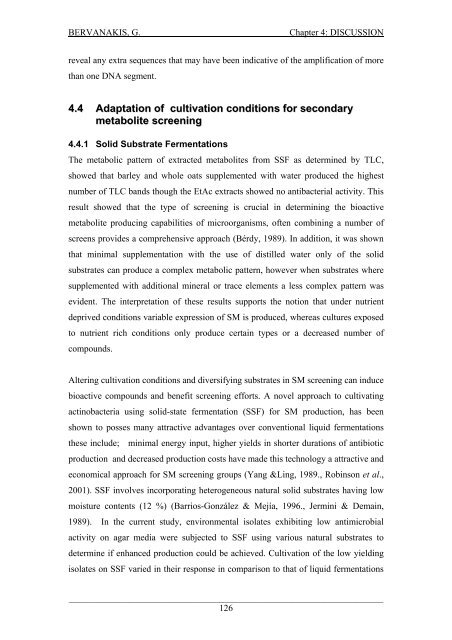Detection and Expression of Biosynthetic Genes in Actinobacteria ...
Detection and Expression of Biosynthetic Genes in Actinobacteria ...
Detection and Expression of Biosynthetic Genes in Actinobacteria ...
You also want an ePaper? Increase the reach of your titles
YUMPU automatically turns print PDFs into web optimized ePapers that Google loves.
BERVANAKIS, G.Chapter 4: DISCUSSIONreveal any extra sequences that may have been <strong>in</strong>dicative <strong>of</strong> the amplification <strong>of</strong> morethan one DNA segment.4.4 Adaptation <strong>of</strong> cultivation conditions for secondarymetabolite screen<strong>in</strong>g4.4.1 Solid Substrate FermentationsThe metabolic pattern <strong>of</strong> extracted metabolites from SSF as determ<strong>in</strong>ed by TLC,showed that barley <strong>and</strong> whole oats supplemented with water produced the highestnumber <strong>of</strong> TLC b<strong>and</strong>s though the EtAc extracts showed no antibacterial activity. Thisresult showed that the type <strong>of</strong> screen<strong>in</strong>g is crucial <strong>in</strong> determ<strong>in</strong><strong>in</strong>g the bioactivemetabolite produc<strong>in</strong>g capabilities <strong>of</strong> microorganisms, <strong>of</strong>ten comb<strong>in</strong><strong>in</strong>g a number <strong>of</strong>screens provides a comprehensive approach (Bérdy, 1989). In addition, it was shownthat m<strong>in</strong>imal supplementation with the use <strong>of</strong> distilled water only <strong>of</strong> the solidsubstrates can produce a complex metabolic pattern, however when substrates wheresupplemented with additional m<strong>in</strong>eral or trace elements a less complex pattern wasevident. The <strong>in</strong>terpretation <strong>of</strong> these results supports the notion that under nutrientdeprived conditions variable expression <strong>of</strong> SM is produced, whereas cultures exposedto nutrient rich conditions only produce certa<strong>in</strong> types or a decreased number <strong>of</strong>compounds.Alter<strong>in</strong>g cultivation conditions <strong>and</strong> diversify<strong>in</strong>g substrates <strong>in</strong> SM screen<strong>in</strong>g can <strong>in</strong>ducebioactive compounds <strong>and</strong> benefit screen<strong>in</strong>g efforts. A novel approach to cultivat<strong>in</strong>gact<strong>in</strong>obacteria us<strong>in</strong>g solid-state fermentation (SSF) for SM production, has beenshown to posses many attractive advantages over conventional liquid fermentationsthese <strong>in</strong>clude; m<strong>in</strong>imal energy <strong>in</strong>put, higher yields <strong>in</strong> shorter durations <strong>of</strong> antibioticproduction <strong>and</strong> decreased production costs have made this technology a attractive <strong>and</strong>economical approach for SM screen<strong>in</strong>g groups (Yang &L<strong>in</strong>g, 1989., Rob<strong>in</strong>son et al.,2001). SSF <strong>in</strong>volves <strong>in</strong>corporat<strong>in</strong>g heterogeneous natural solid substrates hav<strong>in</strong>g lowmoisture contents (12 %) (Barrios-González & Mejía, 1996., Jerm<strong>in</strong>i & Dema<strong>in</strong>,1989). In the current study, environmental isolates exhibit<strong>in</strong>g low antimicrobialactivity on agar media were subjected to SSF us<strong>in</strong>g various natural substrates todeterm<strong>in</strong>e if enhanced production could be achieved. Cultivation <strong>of</strong> the low yield<strong>in</strong>gisolates on SSF varied <strong>in</strong> their response <strong>in</strong> comparison to that <strong>of</strong> liquid fermentations_____________________________________________________________________126















